Our
History
Chapter One
Life is a journey, get on the Red Car
I started collecting wine in 1997 when Mark Estrin, my future business partner, revealed the joy in sharing a great bottle of Syrah. His precise palette, extensive knowledge and ability to describe the subtle nuances of wine made him a respected merchant and the perfect mentor. One afternoon we shared a bottle of Hermitage from the legendary Northern Rhone producer, Jaboulet. The complexity of the wine stunned me, it was rich, deep and concentrated, the aromatics vibrated with licorice, tobacco, olives, earth, iron, blackberries and flowers. I have loved Syrah since that moment, and it turns out, that moment changed my life.
Two years passed and Mark approached me with a proposition; he and a friend, Carroll Kemp, planned to try their hand at winemaking and thought I should join them. I was pretty sure it was a dumb idea, but I liked Mark, and I said yes. It was a low budget project with big ambitions—we purchased a ton of Syrah, a fermentation tank, an oak barrel—and set out to make wine. Our first vintage, the year 2000, consisted of 50 cases of Syrah produced in a Culver City garage.
The label featured a drawing of an old Los Angeles Pacific Electric Trolley Car and the words “Red Car” in a bull’s-eye. In a prior life Estrin had been a screenwriter and Kemp had been a film producer. The highly stylized approach to our early marketing married Mark’s background as a writer and his experience selling wine. The distinctive front label was a nod to a romantic, idealized past in our home city of Los Angeles. For the back label, Mark wrote a vignette with a tip of the hat to Raymond Chandler:
“The Window”
I walked to the window and pulled back a thin, tobacco-stained curtain. What passed for a breeze from the street below was hot and close and remorseless. Then a westbound Red Car trolley lumbered by, filled with people. For a fleeting moment, I imagined I was in that Red Car, heading to the beach, where the air was fresh and clean and cool. Riding the Red Car to the edge of the continent, to the edge of everything.
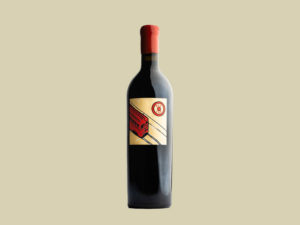
From then on, the back label of each wine carried lines of prose written by Estrin: one passage per vintage, each offering a new chapter in an ongoing 1940s era noir melodrama.
“The Window” was surprisingly good—a view shared by several of Mark’s friends who, conveniently, were sommeliers. These early supporters added the wine to their lists at The French Laundry, Spago, Charlie Trotter’s and several other highly respected restaurants.
The first 50 cases sold quickly, and we declared ourselves a “business.” Production moved from the garage to a custom crush facility in Santa Maria and we retained wine maker Tim Spear as an adviser. For the next three years Mark, Carroll and Tim sourced fruit from a number of vineyards and made wines that met with critical acclaim from Robert Parker, who praised the Syrah writing “Red Car has the Midas Touch when it comes to producing wines of character and richness.”
Encouraged, we added a new wine to the lineup, a Syrah we named “The Fight”. For each vintage we commissioned an original painting for the front label and a serialized installment written by Estrin for the back. The packaging took almost as much work as the wine.
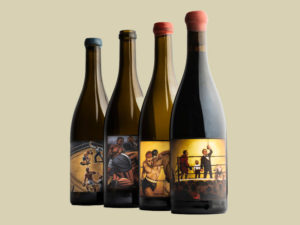
Chapter Two
The Heart of Red Car
In 2003 we bought 128 acres of land in Cazadero perched 1,200 feet above the Pacific Ocean. I had a visceral reaction the first time I drove out to the property. Winding down River Road to Jenner then up Meyers grade to King Ridge we passed through forests of old growth redwood, oak and manzanita, and remote vineyards cooled by ocean breezes. Hawks circled above the trees as sunshine pushed the morning fog back out to sea. It was breathtaking.
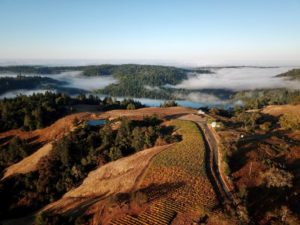
While remote, we were not alone. Our neighbors Hirsch, Marcassin, Flowers, Peay and a handful of others had already crafted beautiful wines from vines struggling to produce in this cool and changeable environment. Inspired by their success we retained local winemaker David Ramey as a consultant, Daniel Roberts to select clones and install the vineyard, and Ulises Valdez to lead the farming. Carroll and Mark worked around the clock to get the project launched.
In 2004 our team gathered for a dinner to celebrate the launch of the new vineyard and the critical success of our third vintage. At the table, Mark announced that he was leaving his sales job at the Wine House to dedicate himself fully to building Red Car. He was determined to realize his dream. “When it’s your own vineyard”, he said, “you’re not just selling a bottle of wine. You’re selling your hard work, your time, your imagination, your hopes and dreams.” There were toasts and speeches as we welcomed the future.
But life takes cruel turns, and just as we prepared to plant the vineyard Mark was diagnosed with cancer. Should we press on or should we pause? Mark insisted we continue. “The new vineyard” he said, “will be the heart of Red Car.” And with that we decided to plant our first, and now oldest vines.
A little over a year passed, and in early spring Mark called and asked me to come by his house. He had been declining and I was unsure what to expect. When I arrived he was resting and waved me closer. In a whisper he told me he had decided to stop further treatment —- he was prepared to let nature take its course. He looked me in the eye, “promise me you will finish the vineyard”. As I nodded I would, he recounted something he had been pondering:
“It is said that when we enter this world, the soul breaks into 22 pieces. Our quest in life is to gather up each piece to become whole again.”
He paused and looked at me, “Richard, I want you to know that Red Car is my twenty second piece”. I was speechless; moved that I had helped Mark find peace, but deeply saddened that our journey was near its end. Two months later Mark was gone.
After the memorial service, Carroll and I pledged that in future years when the fruit from our old vines was exceptional it would be vinified as Cuvee 22 in honor of Mark and the journey we shared. The initial label bore a picture of Mark when he was 22 years old. The wine was syrah.
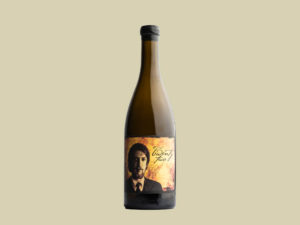
We pressed on, planting blocks of Syrah, Pinot Noir and Chardonnay in the new vineyard. We envisioned that this place we now called the Estate, would ultimately be surrounded by a small constellation of unique vineyards in Fort Ross/Seaview, Occidental and Freestone, all within the True Sonoma Coast. Carroll began seeking out and experimenting with fruit from several new sites. Only time would tell which would make the cut…
Chapter Three
True North
In 2006, while looking for new vineyards to complement the Estate, we met the Hanlein and Coletti families. Co-owners of a pristine 500-acre ranch in Occidental, they had recently developed a vineyard site where soil and climate were perfect for growing Pinot Noir. We jumped at the chance to sign a lease, and in 2007 produced the first wine from the site. Inspired by the quality of the fruit and the natural beauty of the place, we named it Heaven & Earth. The label bore an ethereal photo of coastal fog settling over fall colors in the vineyard. No Red Car branding disturbed the serenity of the shot.
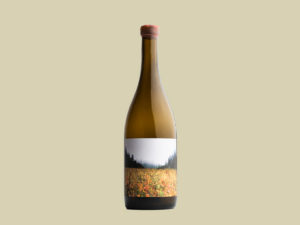
In 2009 we released the wine, and that same year Wine Spectator published a cover story: “Best Ever California Pinot Noir”. James Laube, one of the magazine’s top critics wrote, “Just when you think California Pinot Noir can’t get any better, it does”. He awarded the 2007 Heaven & Earth 97 points, published a picture of the vineyard, and put an image of the bottle on the cover of the magazine.
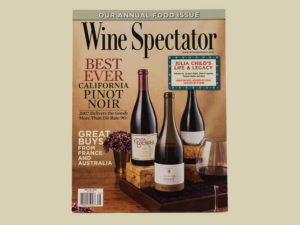
It was marketing gold except for one thing—-the front label had no identifying brand. We felt like a bunch of knuckleheads! Over two million readers, and no one could identify the wine! Despite some initial confusion, wine lovers did figure it out and the vintage sold out overnight. Heaven & Earth continues to be one of our most sought after wines today.
Over the next several years we worked with excellent, and in some cases renowned, vineyards including Platt, Ritchie, Doc’s Ranch, Zephyr Farms, Hawk Hill, Manchester Ridge and the Hagan Vineyard.
It was a learning process, and in time we winnowed the group down by asking ourselves three questions: first, can these sites naturally lend to the style of wine we aspire to make, wines of typicity, with fresh and pure aromatics that speak to the place and the people behind the glass; second, can we establish a long-term business relationship beneficial to both parties; and, third, can we manage the farming.
The benefits of having our own dedicated farming operation were clear, and in 2012 we were fortunate to partner with Greg Adams, an accomplished and widely respected viticulturist. For the next 5 years Greg consulted on all our farming activity and in 2017 assumed the management of all Red Car vineyards. We credit the success of our wines to the close relationship between winemaker and viticulturist, and the years of local knowledge our team has developed.
In 2010, having identified several excellent vineyards it was time to consolidate all winemaking and business operations in one place. We chose Sebastopol, and Carroll identified the perfect space— an abandoned tractor dealership— which we transformed into a winery, a business office and a tasting room; our home for the past decade.
As Red Car evolved, we streamlined the business, paring back the number of vineyards and bottlings, and, importantly, the number of labels. When Mark passed, we lost the ability to create the vignettes that graced our early labels and were left to experiment with new ways to differentiate our wines. Predictably, over a number of years we achieved chaos.
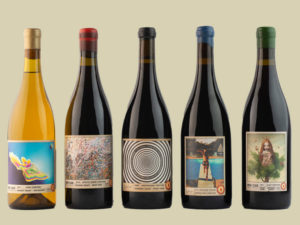
While it was eye catching, this hyper-creativity caused lots of confusion in the marketplace. We wanted to present a simpler, more cohesive brand and realized that the elements defining our “True North”, the soils, the proximity to the Pacific Ocean and the unique geography of the place were the story. The geography and vineyard locations pictured on the new labels would speak for the wines inside.
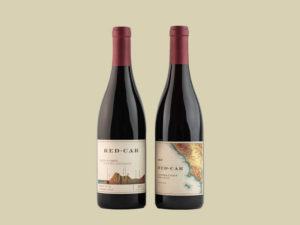
First conceived in 2013 our Rose of Pinot Noir emerged well ahead of the current flood tide of Rose in the market. Consumers loved the tightly wound aromatics of bright fresh fruit, coupled with racy natural acidity and unique textures from barrel fermentation and lees contact. Somehow this wine would feel constrained in our standard package. So, we created a label that accented the wine’s pale pink color and paired it with a hock bottle to emphasize the structure and pure joy of the wine within. Unexpectedly we created a hit and the Rose quickly became our top selling product.
Sometimes thinking outside the box pays off…
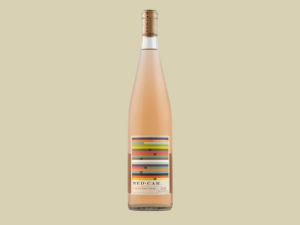
Chapter Four
The Stuff of Dreams
In 1997 my friend Mark Estrin poured me a glass of Syrah from the Northern Rhone. It was a simple act that inspired a dream and set off a chain of events that gave rise to a vineyard yielding cool climate Syrah in one of the most beautiful places on earth, the Fort Ross-Seaview AVA on the Sonoma Coast.
Two decades later the 2018 growing season delivered everything we look for in a stellar Sonoma Coast vintage: cool, moderate temperatures and plenty of sunshine allowed for slow and even maturation on the vine. First Pinot Noir then Chardonnay ripened throughout September, and each pick reflected the true character of the vintage, varietal, and clone; we began to understand just how special the vintage was. In October the Syrah fruit was finally ready to come in from the coast. We concluded harvest with a final pick from three separate blocks at the Estate, where the dark black bunches hinted at their potential with unmatched depth and concentration. Just as the weather began turning colder, nudging towards the long months of winter, we had done it. We were picked out.
In the summer of 2020, I tasted that Syrah from barrel. It was deep purple, rich, and concentrated yet weightless. The aroma—blackberry, smoked meat, licorice, iron, and flowers reminded me of that bottle of Syrah we enjoyed 23 years before. I silently toasted to Mark and wondered if people would notice how special the wine was.
It didn’t take long to find out.
In January 2021 wine critic Antonio Galloni released his review: “The 2018 Syrah Estate is another gorgeous wine that captures a mix of depth and vibrancy. Inky dark blue/black fruit, black pepper, savory herbs, mint, and lavender convey intensity and grace at the same time. There is a feeling of translucence to the 2018 that is so beguiling.” I read the review and had my answer—- people would notice.
Now and then you get lucky, and your dream comes true.
Email List Signup
Sign up to receive updates on current releases, events and news from our winemaking team in the West Sonoma Coast
